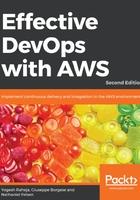
Recreating our Hello World example with CloudFormation
Designer and CloudFormer are two very useful tools when you are in the process of architecting your infrastructure and trying to add source control to your design. That said, whenever you wear your DevOps hat, it's a different story. Using those tools markedly reduces the added value that CloudFormation provides by using the JSON format. If you got a chance to read some of the templates available, or tried to use CloudFormer on your existing infrastructure, you probably noticed that raw CloudFormation templates tend to be fairly long and not Don't Repeat Yourself (DRY).
From a DevOps perspective, one of the most powerful aspects of CloudFormation is the ability to write code to dynamically generate those templates. To illustrate that point, we are going to turn to Python, and a library called troposphere, to generate our Hello World CloudFormation template.